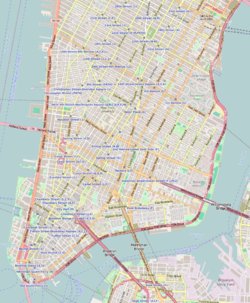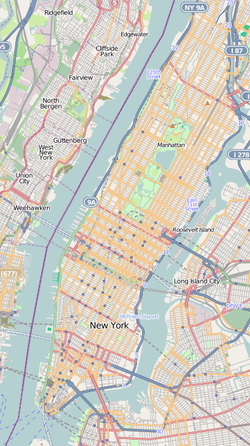South Street Seaport Museum
|
South Street Seaport
|
|

South Street and Brooklyn Bridge (c.1900)
|
|
| Location | Bounded by Burling (John St.) and Peck Slips, Water St. and East River in New York City, United States |
|---|---|
| Coordinates | Coordinates: 40°42′22″N 74°0′12″W / 40.70611°N 74.00333°W |
| Area | 3.5 acres (1.4 ha) |
| Architect | multiple |
| Architectural style | Greek Revival |
| NRHP Reference # | |
|
South Street Seaport Historic District
|
|
| Location | Roughly bounded by East River, Brooklyn Bridge, Fletcher Alley, and Pearl and South Streets, Manhattan, New York City, United States |
| Area | 41 acres (17 ha) |
| Architectural style | Greek Revival, Romanesque |
| NRHP Reference # | 78001884 |
| Added to NRHP | December 12, 1978 |
| Added to NRHP | October 18, 1972 |
The South Street Seaport is a historic area in the New York City borough of Manhattan, centered where Fulton Street meets the East River, and adjacent to the Financial District. The Seaport is a designated historic district, and is distinct from the neighboring Financial District. It is part of Manhattan Community Board 1 in Lower Manhattan, and is bounded by the Financial District to the west, southwest, and north; the East River to the southeast; and Two Bridges to the northeast.
It features some of the oldest architecture in downtown Manhattan, and includes the largest concentration of restored early 19th-century commercial buildings in the city. This includes renovated original mercantile buildings, renovated sailing ships, the former Fulton Fish Market, and modern tourist malls featuring food, shopping, and nightlife, with a view of the Brooklyn Bridge.
The first pier in the area appeared in 1625, when the Dutch West India Company founded an outpost here. With the influx of the first settlers, the area was quickly developed. One of the first and busiest streets in the area was today's Pearl Street, so named for a variety of coastal pearl shells. Due to its location, Pearl Street quickly gained popularity among traders. The East River was eventually narrowed. By the second half of the 17th century, the pier was extended to Water Street, then to Front Street, and by the beginning of the 19th century, to South Street. The pier was well reputed, as it was protected from westerly winds and ice of the Hudson River.
...
Wikipedia





